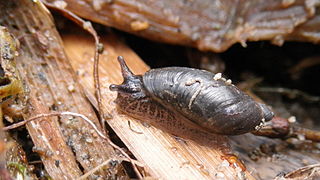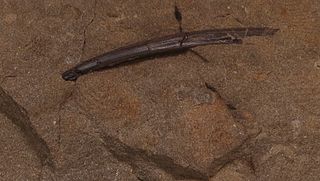
Caenorhabditis elegans is a free-living transparent nematode about 1 mm in length that lives in temperate soil environments. It is the type species of its genus. The name is a blend of the Greek caeno- (recent), rhabditis (rod-like) and Latin elegans (elegant). In 1900, Maupas initially named it Rhabditides elegans. Osche placed it in the subgenus Caenorhabditis in 1952, and in 1955, Dougherty raised Caenorhabditis to the status of genus.

Oxyloma elegans is a species of small European land snail, a terrestrial pulmonate gastropod mollusk belonging to the family Succineidae, the amber snails.

The Harpactorinae are a large subfamily of the Reduviidae. About 300 genera and 2,000 species worldwide have been described. Some of the species of the genera Zelus, Pselliopus, Sinea, and Apiomerus are of interest as biological pest control agents.

The Apiomerini are a tribe of the Harpactorinae. This tribe is restricted to the New World and consists of 11 genera.

Harpactorini is a tribe of the Harpactorinae. This group is the most diverse of the entire assassin bug family, with 51 genera recognized in the Neotropical Region and 289 genera and 2003 species overall.
Liangcoris is a monotypic genus of assassin bugs, in the subfamily Harpactorinae, native to China, containing a single species, Liangcoris yangae.

Euagoras is a genus of assassin bugs, in the subfamily Harpactorinae. Species are found in Asia and Australia.

Tritoniopsis elegans is a species of dendronotid nudibranch. It is a marine gastropod mollusc in the family Tritoniidae and is found in the western Indo-Pacific. It was first described by the French naturalist Jean Victoire Audouin in 1826, the type specimen being found in the Red Sea.

Pselliopus is a common genus of assassin bugs (Reduviidae), in the subfamily Harpactorinae. The genus is restricted to the New World, with 27 species described. Some species, such as Pselliopus barberi, are conspicuous because of their bright coloring and relatively large size. Some species of the genus are of interest as potential biological pest control agents.
The Radiological Research Accelerator Facility (RARAF), located on the Columbia University Nevis Laboratories campus in Irvington, New York is a National Institute of Biomedical Imaging and Bioengineering biotechnology resource center (P41) specializing in microbeam technology. The facility is currently built around a 5MV Singletron, a particle accelerator similar to a Van de Graaff.

Cymothoe coranus, the blonde glider or coast glider, is a butterfly of the family Nymphalidae. It is found from South Africa to Zimbabwe, Kenya, Malawi and Tanzania.
The elegant coral snake is a species of elapid snake, native to southern Mexico and Guatemala. There are two recognized subspecies.
Diegocanis is an extinct genus of cynodonts from the Late Triassic (Carnian) of Argentina. The type species, Diegocanis elegans, was named in 2013 from fossils found in the Cancha de Bochas Member of the Ischigualasto Formation in the Ischigualasto-Villa Unión Basin. Diegocanis was classified within a new family of probainognathian cynodonts called Ecteniniidae, along with the genera Ecteninion and Trucidocynodon.
Mionochroma elegans is a species of beetle in the family Cerambycidae. It was described by Olivier in 1790. It is known from Guadeloupe, Grenada, Dominica, and St. Lucia.
Clavagella is a genus of marine bivalves in the family Clavagellidae.

Coranus is a genus of assassin bugs in the tribe Harpactorini.

Catenipora is an extinct genus of tabulate corals in the family Halysitidae, known from the Ordovician to the Silurian.

Cattleya × elegans is a hybrid orchid in the subtribe Laeliinae. It is a pseudobulb epiphyte. Its formula hybridae is Cattleya purpurata Van den Berg (2008) × Cattleya tigrina A.Rich. (1848). It is found in South and South-East Brazil.

Cosmacanthus is an extinct genus of placoderms in the extinct family Groenlandaspididae that lived during the Late Devonian in Ireland, the UK, Russia and North America. It was named by Louis Agassiz in 1845.
The Dicrotelini are a tribe of assassin bugs in the subfamily Harpactorinae. Originally described by Carl Stål, genera and species have been recorded from Asia and Australia.












